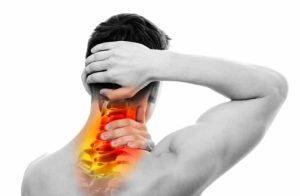What Is Cervicalgia and How Physiotherapy Can Help
Neck pain, more precisely called “Cervicalgia,” is a very common condition that can affect people across a wide age range, most often between 18 and 55 years old. The symptoms experienced by patients can be very diverse.
The Task Force of the Bone and Joint Decade (TBJD) generally describes issues related to the cervical spine as “pain localized in the anatomical region of the neck, with or without radiation to the head, trunk, and upper limbs,” identifying four types of cervical pain based on symptom severity and their impact on daily life:
Grades of Cervicalgia
- Grade 1: neck pain without radiating signs or symptoms, with no or minimal limitations in daily living activities (ADL);
- Grade 2: neck pain without radiating signs or symptoms but with some limitations in daily activities;
- Grade 3: neck pain with neurological signs of radicular compression (such as altered sensitivity, tingling, pins and needles, or burning sensations down the upper limb to the hand);
- Grade 4: neck pain with signs and symptoms of a more serious structural condition (such as fractures, infections, tumors, or systemic diseases).
But what are the main causes that can lead someone to develop neck pain? The two primary factors appear to be a sedentary lifestyle and a high body mass index (BMI), in other words, being overweight. Another very important factor in the development of neck pain, particularly common in modern society, is the frequent extension of the neck during the day—especially for those who spend all day at the computer with the head and gaze leaning toward the screen.
Finally, it has been observed that a person suffering from low back pain and/or thoracic pain is more predisposed than a healthy subject to also develop cervicalgia. This suggests that pain or lack of movement in one area can lead to compensations in adjacent joints, “overloading” other parts of the body that were initially pain-free.
Cervicalgia and Trauma
A separate discussion should be made for all cases of cervicalgia caused by trauma or injury, such as the classic “whiplash,” where there is an evident cause-and-effect relationship between the traumatic mechanism and the pain experienced by the patient.
When managing a patient presenting with neck pain, the process always starts with anamnesis. Beginning with the symptoms reported by the patient (intensity and location of pain), the clinician will then investigate which daily activities are affected by cervicalgia. Doubts, fears, and beliefs the person holds about their symptoms are also explored, to educate the patient and, by providing a clearer understanding of the situation, make them an active participant in the rehabilitation process.
After anamnesis, a physical evaluation follows, including physiological movements of the cervical spine (flexion, extension, rotation, and lateral inclinations) and orthopedic and neurological functional tests to identify which tissues may be responsible for the pain.
How the Physiotherapist Intervenes
Functionally, the cervical spine is divided into upper, middle, and lower cervical regions. The physiotherapist has several tools that can be used to treat these areas in order to relieve pain and, where needed, improve mobility in a stiff or hypomobile neck: myofascial massage, joint mobilizations, and manipulations. It is up to the therapist to decide which technique is most suitable for the patient in front of them and which area to target.
Once the acute phase has passed, it is important to start an exercise program aimed at strengthening the muscles, to prevent or at least reduce the risk of recurrence. The rehabilitation plan must always be tailored to the individual, not only in terms of exercise type but also volume and intensity.
Generally speaking, studies show that strengthening exercises for the muscles of the neck, shoulders, and back have medium- to long-term benefits for people with neck pain. Aerobic exercise also deserves mention: for people with chronic cervicalgia (lasting several months), even though it works on the whole body, it has a positive impact on perceived pain.
Ultimately, the road to recovery always goes through movement. There is no “magic pill” that makes pain disappear instantly, but physical activity is certainly the best resource we have to feel better. So, always rely on professionals who encourage active movement and physical activity in general.


